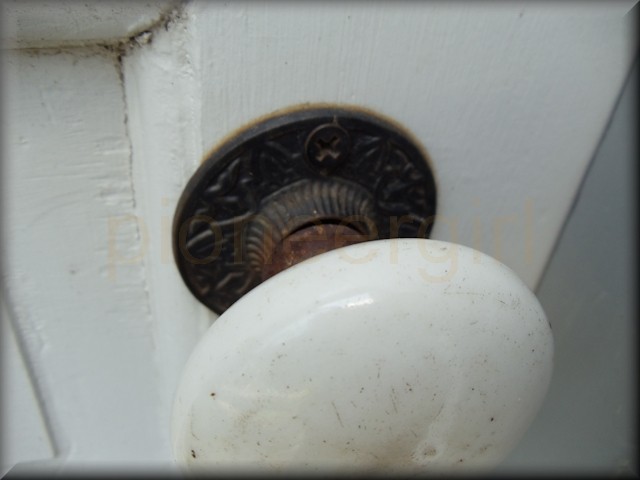door knob

A hard protuberance; a hard swelling or rising; a bunch; as, a knob in the flesh, or on a bone; hence, a round ball at the end of any thing, as the knob of a door lock. — Webster, 1882
 Into those doors Pa set boughten locks, with keys that went into small, shaped holes, and turned and clicked. These locks had white china door knobs. — On the Banks of Plum Creek, Chapter 16, “The Wonderful House”
Into those doors Pa set boughten locks, with keys that went into small, shaped holes, and turned and clicked. These locks had white china door knobs. — On the Banks of Plum Creek, Chapter 16, “The Wonderful House”
 When the construction of a door that functions without benefit of door knob is important enough to write about (see Little House on the Prairie, Chapter 8, “Two Stout Doors”), so is the luxury of a house with a white china knob on its front door (see above). The Ingalls family also had a china knob on the parlor door of their Third Street house in De Smet; it is shown at right.
When the construction of a door that functions without benefit of door knob is important enough to write about (see Little House on the Prairie, Chapter 8, “Two Stout Doors”), so is the luxury of a house with a white china knob on its front door (see above). The Ingalls family also had a china knob on the parlor door of their Third Street house in De Smet; it is shown at right.
 Do you recognize the Little House doorknob shown at left? It’s from Laura and Almanzo Wilder’s Rock House in Mansfield, Missouri. Do you pay attention to the doorknobs when you visit the heritage homesites? Laura Ingalls Wilder wrote that the back door to lean-to of the Surveyors’ House in De Smet had a white china knob. Is it still there? Does the Wayside cabin near Independence, Kansas, open with a latch or a knob?
Do you recognize the Little House doorknob shown at left? It’s from Laura and Almanzo Wilder’s Rock House in Mansfield, Missouri. Do you pay attention to the doorknobs when you visit the heritage homesites? Laura Ingalls Wilder wrote that the back door to lean-to of the Surveyors’ House in De Smet had a white china knob. Is it still there? Does the Wayside cabin near Independence, Kansas, open with a latch or a knob?
What kind of doorknob is on your own front door? Is it polished brass, clear glass, white china, or made of some other material? Is it plain or fancy? What about your bedroom door? Start noticing all the different kinds and shapes of doorknobs you see, just like Laura did.

knob (FB 12, 28), see also nub
door knob / doorknob (LHP 8; BPC 16, 19, 35; SSL 14; TLW 9)
flail (FB 25)
glass insulators (SSL 3), see telegraph

